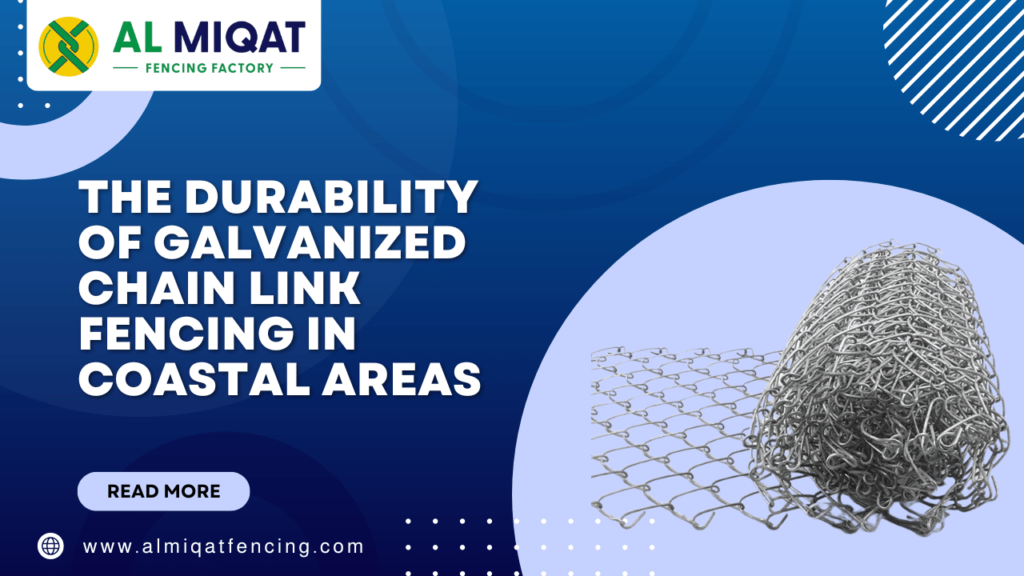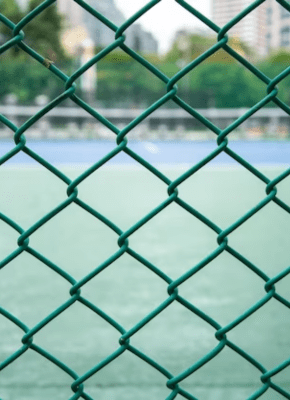When it comes to choosing a fencing solution for coastal areas, durability is key. Coastal environments are known for their harsh conditions, including saltwater exposure, high humidity, and corrosive winds. In such environments, selecting the right material for fencing is crucial to ensure longevity, security, and low maintenance. Galvanized chain link fencing stands out as one of the best options for these challenging conditions, offering robust protection against the elements.
At Al Miqat Fencing Manufacturer, we specialize in producing high-quality galvanized chain link fences that provide excellent durability and resistance to the corrosive effects of coastal environments. In this blog, we will explore why galvanized chain link fencing is ideal for coastal areas and how it can withstand the test of time in such demanding conditions.
1. What Makes Galvanized Chain Link Fencing So Durable?
Galvanized chain link fencing is made from steel that has been coated with a layer of zinc, which is a highly effective material for corrosion resistance. The process of galvanization involves coating the steel wire with molten zinc to form a protective barrier. This coating not only increases the lifespan of the fence but also helps it to resist various environmental stressors, particularly in coastal areas.
Key Advantages:
- Corrosion Resistance: Zinc is known for its excellent ability to protect steel from corrosion. In coastal areas where saltwater and moisture are prevalent, galvanized steel resists rust and deterioration, ensuring that the fence remains intact and functional for a long time.
- Long-Lasting Performance: The galvanization process extends the lifespan of the chain link fence significantly. While untreated steel may corrode and weaken in just a few years in coastal environments, galvanized chain link fencing can last for decades, making it a cost-effective investment.
- Low Maintenance: Once installed, galvanized chain link fences require minimal upkeep. The protective zinc coating helps prevent the formation of rust and corrosion, reducing the need for frequent maintenance or repairs.
2. Galvanized Chain Link Fencing and Saltwater Resistance
One of the most significant challenges for fencing in coastal regions is the presence of saltwater. Saltwater is highly corrosive and can cause severe damage to many materials, particularly metals. For this reason, galvanized chain link fencing is an ideal choice for coastal areas.
How It Resists Saltwater:
- Zinc Coating’s Protective Layer: When galvanized steel is exposed to saltwater, the zinc coating forms a protective oxide layer, which prevents the underlying steel from coming into contact with moisture. This layer essentially acts as a barrier, preventing rust from forming and ensuring the longevity of the fence.
- Self-Healing Properties: Over time, if the zinc coating is scratched or damaged, the exposed steel does not corrode as quickly as untreated steel. The zinc will continue to protect the damaged area by “self-healing” through the process of galvanic corrosion, which prevents the spread of rust.
Applications in Coastal Areas:
- Beachfront Properties: Coastal properties with direct access to the beach often require fencing that can withstand the harsh effects of saltwater exposure. Galvanized chain link fencing is perfect for these properties as it keeps the structure intact without deteriorating over time.
- Marinas and Ports: Areas near marinas or ports, where the saltwater is a constant presence, benefit from galvanized chain link fencing due to its corrosion resistance. The fence remains secure and effective at defining boundaries or securing facilities, even in such harsh environments.
3. Galvanized Chain Link Fencing and Coastal Winds
In addition to saltwater exposure, coastal areas are also characterized by strong winds that can put a strain on fences. Chain link fencing is already known for its strength, but when combined with galvanization, it becomes even more resilient against high winds and storms.
How Galvanized Chain Link Fencing Handles Coastal Winds:
- Flexibility and Strength: Galvanized chain link fences are designed to bend rather than break under pressure. This flexibility helps them withstand strong winds and storms without becoming damaged or unstable.
- Wind Resistance: The open design of chain link fences allows wind to pass through the mesh, reducing the wind load on the fence and minimizing the risk of structural damage. This feature makes galvanized chain link fencing ideal for coastal areas where winds can be particularly fierce.
Applications in Coastal Winds:
- Coastal Properties with Open Spaces: Coastal homes, agricultural lands, and recreational areas benefit from the wind-resistant properties of galvanized chain link fences. The open design allows for air flow while providing the necessary barrier.
- Seaside Parks and Walkways: Public spaces such as parks, boardwalks, and seaside pathways often face the challenge of coastal winds. Galvanized chain link fencing provides a durable solution that can withstand wind exposure while enhancing the property’s security and boundary definition.
4. Low Maintenance and Cost-Effectiveness
Another standout feature of galvanized chain link fencing is its low-maintenance nature, particularly in coastal areas where other materials might require frequent care and repairs. The durability of galvanized steel in coastal conditions makes it an incredibly cost-effective option for long-term fencing solutions.
Benefits for Coastal Property Owners:
- Reduced Maintenance Costs: Traditional fencing materials like wood or untreated steel often require regular painting, sealing, or repairs, especially in coastal areas. Galvanized chain link fencing, on the other hand, requires little to no maintenance over its lifespan, which significantly reduces maintenance costs.
- Long-Term Value: The initial cost of installing a galvanized chain link fence may be higher than some other fencing materials, but due to its long-lasting nature, it proves to be a better investment in the long run. Homeowners and business owners can enjoy the benefits of a durable fence without the ongoing costs associated with repairs and replacements.
5. Environmentally Friendly Option
While galvanized chain link fencing offers unparalleled durability in coastal areas, it also provides an environmentally friendly option for property owners. The zinc coating used in galvanization is highly sustainable, and the fence itself can be recycled at the end of its lifespan.
Sustainability Benefits:
- Recyclable Materials: Zinc, along with steel, is a highly recyclable material. At the end of the fence’s life, it can be recycled, reducing the environmental impact of fencing installation.
- Long-Lasting and Sustainable: By choosing galvanized chain link fencing, property owners are making a sustainable choice, as the long lifespan of the fence reduces the need for replacements, conserving resources over time.
6. Conclusion
For properties located in coastal areas, where exposure to saltwater, high winds, and humidity can take a toll on fencing materials, galvanized chain link fencing offers a reliable, long-lasting, and cost-effective solution. The galvanized coating provides exceptional corrosion resistance, ensuring the fence remains strong and secure for decades, even in the most challenging coastal environments.
At Al Miqat Fencing Manufacturer, we specialize in providing high-quality galvanized chain link fencing that is designed to withstand the rigors of coastal conditions. Whether you’re protecting a beachfront property, a marina, or any coastal facility, galvanized chain link fencing offers the perfect combination of durability, low maintenance, and environmental sustainability.
For more information on how galvanized chain link fencing can meet your needs in coastal areas, contact Al Miqat Fencing Manufacturer today. Let us help you invest in a fence that will stand the test of time and the elements.


